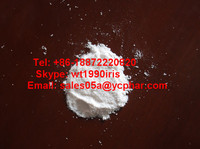L-Glutamine CAS 56-85-9 / SKYPE wt1990iris(OAP-031)
Product Quick Detail
- For Any Further Information
- sales05a AT ycphar DOT com
- Steroids
- http://cnrdn.com/WuUE
- Skype
- wt1990iris
- Packaging
- negotiable
- Delivery
- 4 Days
Specifications
Product Name: L-Glutamine
Synonyms: L(+)-Glutamine; L(+)-Glutamic acid-5-amide; L-Glutamine, FCC Grade L-2-Aminoglutaramic acid, FCC Grade; levoglutamide; H-Gln-OH; L-Glutamic acid 5-amide; L-Glutamine; D-glutamine; alpha-glutamine; 2,5-diamino-5-oxo-pentanoic acid;;
L-Glutamine CAS No.: 56-85-9
L-Glutamine EINECS No.: 200-292-1
L-Glutamine Molecular formula: C5H10N2O3
L-Glutamine Molecular weight: 146.15
L-Glutamine Appearance: white powder
L-Glutamine Category: food additives
L-Glutamine Description
1. L- glutamine is the most abundant amino acid found in human muscle and plasma. Over 60% of the free-floating amino acid pool in skeletal muscle cells is made up of L
glutamine. It is also a primary nitrogen donor, meaning that it moves the nitrogen around in the body to where it is needed. Maintaining a positive nitrogen balance is absolutely necessary for
muscle building.
2. L-glutamine was once considered a non-essential amino acid because the body can make its own from the amino acids glutamic acid, isoleucine and valine. Recently, however, is
has become known as a conditionally essential amino acid because in times of physical stress, such as intense exercise and surgery, the body requires more of it to maintain its glutamine stores
in blood and muscle. When glutamine stores are depleted, you may experience decreases in strength, stamina, and recovery.
Product Specification
L-Glutamine Use
Growth of muscles, mainly achieved through the following aspects:
Provide the necessary nitrogen source for the body, promote muscle intracellular protein into the whole; Compatibilization of cells and promote the growth and differentiation of
muscle cells; Stimulate the secretion of growth hormone, insulin and testosterone, the body is synthesized state.
Increase strength, improve endurance.
Important fuel of the immune system, enhance immune system function.
Involved in the synthesis of the valley walking on glutathione (an important antioxidant).
The gastrointestinal lumen basic energy source of the cell.
Improve brain function.
To maintain the normal function of the kidneys, pancreas, gallbladder and liver.
L-Glutamine Function
1. L-Glutamine is the most prevalent amino acid in the bloodstream.
2. L-Glutamine is involved in more metabolic processes than any other amino acid.
3. L-Glutamine is converted to glucose when more glucose is required by the body as an energy source.
4. L-Glutamine also plays a part in maintaining proper blood glucose levels and the right pH range.
5. L-Glutamine serves as a source of fuel for cells lining the intestines. Without it, these cells waste away.
6. L-Glutamine is also used by white blood cells and is important for immune function.
7. L-Glutamine assists in maintaining the proper acid/alkaline balance in the body, and is the basis of the building blocks for the synthesis of RNA and DNA.
- Country: China (Mainland)
- Business Type: Manufacturer
- Market:Asia,Europe,Americas,Oceania
- Founded Year:2001
- Address:
- Contact:Iris Wu










